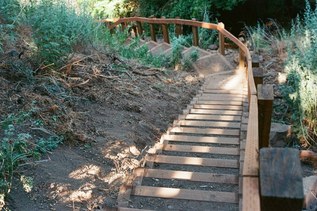This high mountain ridge trail in the far northeast corner of Washington (and crossing into the far northwest corner of Idaho) starts high and stays high, offering numerous options for dayhikes and extended backpack trips of various lengths.
From its beginning at Pass Creek Pass, the first sweeping panoramic views come within the first mile of the hike as the trail contours along the eastern flank of Round Top Mountain. The trail crosses a high alpine meadow typical of northeast Washington, where hikers can see alpine flowers blooming amidst sagebrush, with an outstanding view of the Idaho Selkirks in the near distance to the east.
The trail continues past Mankato Mountain to a first good campsite with a small nearby water-source at approximately four miles, the site of an old Forest Service cabin noted as Aces High Cabin on old USGS maps. From there, the trail continues past Helmer Mountain to the first major trail junction and another small campsite near water at approximately the 7 mile mark. Here Jackson Creek Trail drops down the eastern drainage into Idaho, a trail frequently utilized by PNT thu-hikers. To the west, Thunder Creek Trail connects from the Sullivan Creek drainage.
Continuing north, the Divide crosses below Thunder Mountain in a little less than two miles. An old, unmaintained trail leads to the summit of Thunder Mountain, former site of a fire lookout tower. This section of trail is known for its early summer beargrass blooms and excellent views of Priest Lake in the distance.
At approximately the 13-mile mark the Divide reaches its next major intersection. From the west, the Shedroof Cut-off Trail connects from the Sullivan Creek drainage, offering the shortest connecting trail (only 1.7 miles to the Sullivan Creek Road). To the east, the Hughes Fork trail drops into Idaho. Two popular loop backpack trips can be created out of the intersecting trails that meet here: the Thunder Creek Loop (formed by connecting Thunder Creek, the Shedroof Divide, and the Shedroof Cut-off Trail from the Sullivan Creek Road), and the Hughes Fork Loop (formed by connecting Hughes Fork Trail, the Shedroof Divide, and the Jackson Creek Trail from near Hughes Meadows). Hikers low on water should drop approximately .25 miles down the Shedroof Cut-off to refill, as the next portion of the Divide is dry.
The trail next continues toward Shedroof Mountain, where another unmaintained spur trail to the summit makes an interesting side trip to a former fire lookout tower. The tower is long gone, but the remote privy remains.
At 15.7 miles, the trail intersects the Salmo Divide Trail (#535). There's a small campsite near the junction and a small seasonal water source nearby. The Salmo Divide forms part of the Salmo Loop, the most popular backpacking loop in the area, connecting with the Salmo Basin Trail (#506) at the trailhead at the end of FR 2220 (Sullivan Creek drainage).
Continuing north, the trail crosses into Idaho in a mile, then reaches the next main campsite with water at 1.4 miles into Idaho, at approximately the 18 mile mark. This campsite is tucked beneath a large rocky outcropping and near some alpine wetlands, just before the trail intersection at Cabinet Pass (trail #315, seldom maintained).
At 20.7 miles, consider the optional sidehike to the summit of Little Snowy Top. Unfortunately, the historic fire lookout perched atop Little Snowy Top burned to the ground in the summer of 2017. The historic structure has been reduced to a pile of melted metal and glass, but the views from this high point are unparalleled. Crowell Ridge is just to the west, Canada is a stone's throw to the north, and the Idaho Selkirks are just to the east.
The northern terminus of the Shedroof Divide is 2.1 miles beyond the Little Snowy Top trail intersection at the point where the Salmo Basin Trail connects from the west. Snowy Top Mountain looms over the trail in this location, and there's a small dry campsite at this far northern end of the Divide.







 Trailhead
Trailhead



